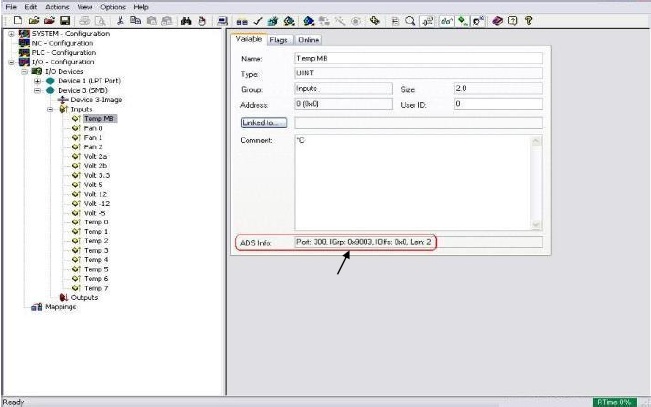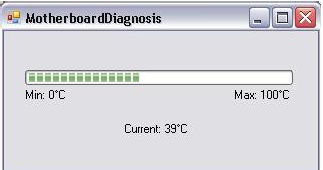Reading of SMB values from TwinCAT I/O driver
Download
Language / IDE | Extract the sample program |
|---|---|
Visual C# | - |
Visual Basic (for .NET Framework) | |
Delphi Prism (Embarcadero Prism XE2, Oxygene for .NET) | - |
Delphi for .NET (Borland Developer Studio 2006) | - |
TX1000 | TwinCAT CP (royalty-free) is a product containing drivers for the Beckhoff Control Panels respectively Control Panel-PC's of the CP6xxx und CP7xxx series, the industrial human machine interfaces from Beckhoff.
It gets typically used if there is no full TwinCAT version considered but basic functions of the Control Panel or Control Panel-PC need to get accessed via application software (like pushbutton extensions or the named SMB (System Management Bus) on supported Motherboards, etc...
TwinCAT CP is a subset of the full TwinCAT suite, means all contained drivers are binary identical to those in the other TwinCAT levels available. Written application software doesn't need to get touched in any way, if TwinCAT CP gets upgraded to a full TwinCAT version later.
Even if only TwinCAT-CP is installed on the controller or HMI device, the SMB device can get accessed by the ADS client (i.e. from a Visual Basic or similar DLL-, Active X- or .NET-capable application).
The visualization allows a continuous supervision of operation temperatures, fan speeds or even the different power supply voltages. That way, the crossing of a critical threshold value can be detected (i.e. if an implementation of an advanced maintenance system is considered). The following example shows a possible implementation under Visual Basic.NET.
Order options:
TwinCAT-CP | License for using the I/O driver for Beckhoff Control Panels for communication between generic Windows applications (alternatively, any other level of TwinCAT of course)
Required software:
- Microsoft.NET Framework version 2.0: http://msdn2.microsoft.com
- Microsoft Visual Studio 2005 or 2008: http://msdn2.microsoft.com
- to create the application "Motherboard Diagnosis“ (see below)
- TwinCAT 2.10: https://www.beckhoff.com/en-en/products/automation/twincat/txxxxx-twincat-2-base/
- during a new installation of TwinCAT:
To install the royalty-free TwinCAT "CP" level, it's important that TwinCAT level "CP" and no other optional level gets selected during the initial installation.
:Note During an Update installation, the previously selected level cannot be changed. Instead, TwinCAT needs to get uninstalled first (in case of a wished upgrade/downgrade).
Visual Basic (for .NET Framework) program
Example: Temperature
1. Add Reference
At first, a Reference to the necessary TwinCAT.Ads.dll needs to be added. The TwinCAT.ADS.NET component gets added via right mouse-click on Project→Add Reference.
2. Determination of device address (here) : Index-Group
Private Sub MotherboardDiagnosis_Load(ByVal sender As System.Object, ByVal e As
System.EventArgs) Handles MyBase.Load
Try
'Create a new instance of class TcAdsClient
tcClient = New TwinCAT.Ads.TcAdsClient()
'Connect to local PLC - Runtime 1 - Port 300
tcClient.Connect(300)
'Gets the device count of devices appended to active configuration if
'TwinCAT is in run mode
Dim state = tcClient.ReadState.AdsState
If Not state = AdsState.Run Then
txtCurrent.Text = "Bad TwinCAT state ("& state.ToString() &").
Please restart application."
Else
Dim deviceCount As UInt32
deviceCount = tcClient.ReadAny(&H5000, &H2,
deviceCount.GetType())
'Gets the device count of devices appended to active
'configuration as zero-based index
'and gets the device ID's of all active devices for the
'remaining indices (inverted sort)
Dim arrayDeviceIDs(deviceCount) As UInt16
arrayDeviceIDs = tcClient.ReadAny(&H5000, &H1,
arrayDeviceIDs.GetType(), New Integer() {deviceCount + 1})
For i As Integer = 1 To (deviceCount)
'gets the device identification number (Motherboard
'System Management Bus(SMB) => 32)
Dim devIdent = tcClient.ReadAny(arrayDeviceIDs(i) +
&H5000, &H7, arrayDeviceIDs(i).GetType)
'checks if the device type is a SMB-Type
If devIdent = 32 Then
_iIndexGroup = &H9000 + arrayDeviceIDs(i)
Exit For
End If
Next
'Enable timer to start monitoring with determined IGroup
tmrTimer1.Enabled = True
End If
Catch ex As Exception
txtCurrent.Text = ex.Message
End Try
End Sub
3. Determination of the Variable address (here: ) Index-Offset
To determine the Index-Offset of the variable, it's very comfortable to use TwinCAT System Manager . By selecting the required Input in the left tree-view, the related window on the right shows the whished address in hexa-decimal notation.

4. Cyclic read update of the value in your application
Private Sub tmrTimer1_Tick(ByVal sender As System.Object, ByVal e As
System.EventArgs) Handles tmrTimer1.Tick
Try
'IOffset may be adjusted to monitor different inputs e.g. fan-speeds
'or voltages
_iTemp = tcClient.ReadAny(_iIndexGroup, 0, _iTemp.GetType())
ProgressBar1.Value = _iTemp
lblCurrent.Text = ("Current: " + (Convert.ToString(_iTemp)) + "°C")
Catch ex As Exception
'Catches if certain circumstances turned TwinCAT to offline mode.
'Restarts monitoring if configuration remains unchanged and TwinCat
'is turned online again.
If ex.Message = "Ads-Error 0x12 : Port is disabled." Then
lblCurrent.Text = "Ports are disabled. TwinCAT may be in
offline mode."
ProgressBar1.Value = 0
Else
MessageBox.Show(ex.Message)
End If
End Try
End Sub
Example: Resulting Message box when exceeding a temperature threshold value
